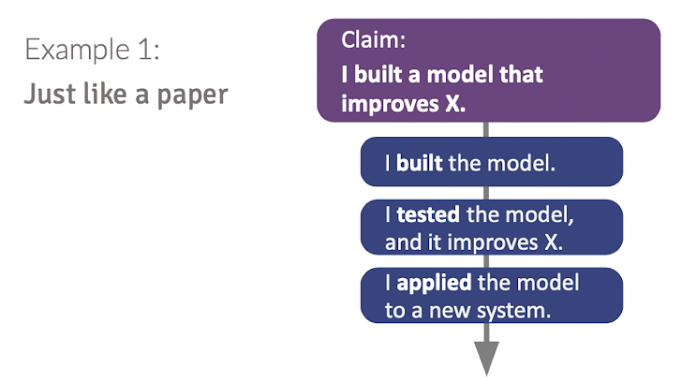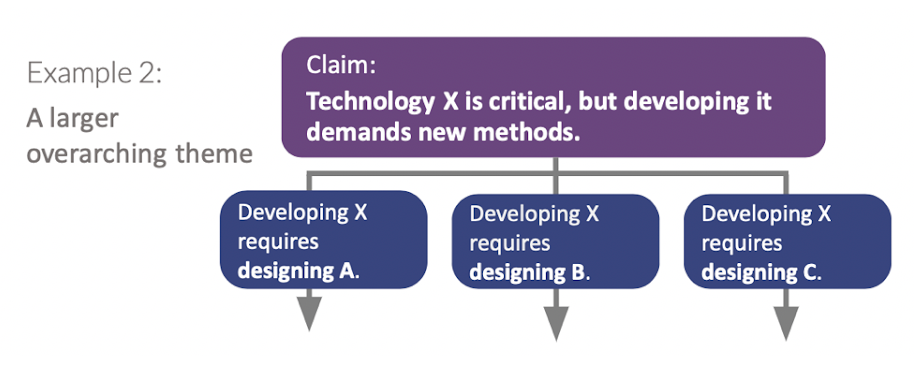1. Introduction
Your master’s thesis serves to explain the research that you have done during your time as a masters student. For many students, the master’s thesis is the longest document that they’ve ever written, and the length of the document can feel intimidating. The purpose of this CommKit is to cover a key element of writing your thesis: the outline.
2. Criteria for Success
The most important criterion for success is that you’ve shown an outline with your chapter breakdown to your advisor. Your advisor is the one that formally signs off on your thesis as completed, so their feedback is the most important.
Every master’s thesis will have the following elements.
- Introduction – Familiarize the reader with the topic and what gap exists in the field.
- Literature Review – Provide a detailed analysis of similar work in the field and how your work is unique. Master’s thesis literature reviews typically have at least 60 citations throughout the entire document
- Methods – Explain how you produced your results
- Results – Show your results and comment on their significance and implications.
- Conclusion – Summarize the methodology you used to generate results, your key findings, and any future areas of work.
3. Purpose
Having an outline for your master’s thesis will help you explain the motivation behind your work, and also connect the different experiments or results that you completed. Furthermore, an outline for your master’s thesis can help break down the larger task of writing the entire thesis into smaller, more manageable chapter-sized subtasks.
4. Analyze Your Audience
The most important audience member for your master’s thesis is your advisor, as they are ultimately the person that signs off on whether or not your thesis is sufficient enough to graduate. The needs of any other audience members are secondary.
Ideally, a good master’s thesis is accessible to people that work in your field. In some cases, master’s theses are passed on to newer students so that that research can continue. In these cases, the thesis is used as a guide to introduce newer students to the research area. If you intend for your thesis to be used as a guide for new students, you may spend more time explaining the state of the field in your introduction and literature review. Additionally, your thesis will be posted publicly on DSpace, MIT’s digital repository for all theses.
5. Best Practices
5.1. Identify Your Claims
A key element to figuring out the unique structure to your master’s thesis is identifying the claims of your work. A claim is an answer to a research question or gap. Your thesis can have both a higher level claim and also lower level claims that motivate the research projects that you worked on. Identifying your claims will help you spot the key objectives which you want to highlight in the thesis. This will keep your writing on topic.
Some examples are shown below:
Gap/Question: There are no field-portable microplastic sensing technologies to measure their distribution in the environment.
→ Claim: Impedance spectroscopy can be used in a microfluidic device to rapidly distinguish organic matter from polymers.
Gap/Question: How effective are convolutional neural networks for pose estimation during in-space assembly?
→ Claim: Convolutional neural networks can be used to estimate the pose of satellites, but struggle with oversaturated images and images with multiple satellites.
5.2. Support Your Claims
Once you have identified your claim, the next step is to identify evidence that will support it. The structure of your paper will be very dependent on the claim that you make. Figure 1 and 2 demonstrate two different structures to support a claim. In one outline, the claim is best supported by a linear structure that describes the building, testing, and validation of a model. In another outline, the claim is best supported by a trifold structure, where three independent methods are discussed. Depending on the extent of the evidence, you could break this trifold structure into 3 separate chapters, or they could all be discussed in a singular chapter. The value of identifying claims and evidence is that it helps you organize your paper coherently at a high level. The number of chapters that are output as a result of your claim identification is up to you and what you think would be sufficient discussion for a chapter within your thesis.

Figure 1.

Figure 2.
5.3. Connect the Evidence to Your Claims with Reasoning
One common mistake that students make when writing their thesis is treating each chapter as an isolated piece of writing. While it is helpful to break down the actual task of thesis writing into chapter-size pieces, these chapters should have some connection to one another. For your outline, it is ideal to identify what these connections were. Perhaps what made you start on one project was that you realized the weaknesses in your prior work and you wanted to make improvements. For readers who were not doing the research with you, describing the connections between your work in different chapters can help them understand the motivation and value of why you pursued each component.
5.4. Combine Your Claims, Evidence, and Reasoning to Produce Your Outline
Once you have identified your claims, the evidence you have surrounding each claim, and the reasoning that connects each piece of your work, you can now create your full outline, putting the pieces together like a jigsaw puzzle. An example outline is provided as an annotated example.
There are no requirements for minimum or maximum number of chapters that your master’s thesis can have. Therefore, when translating your outline to a literal chapter breakdown, you should feel free to use as many chapters as needed. If your methods section for a claim is extremely long, it may make more sense to have it be a standalone chapter, as shown in the attached annotated pdf.
6. Additional Resources
Every IAP, the Comm Lab hosts a workshop on how to write your master’s thesis. This workshop provides tips for writing each of these sections, and steps you through the process of creating an outline.
